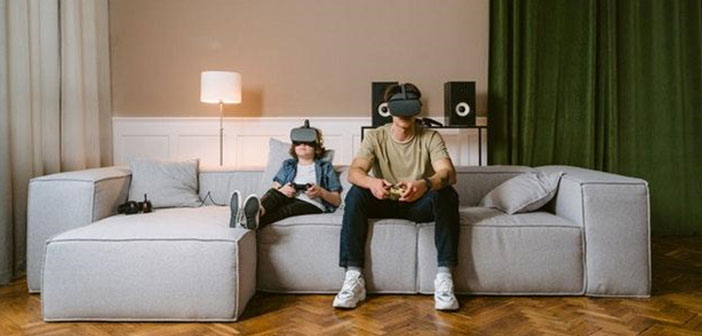If you’re an avid gamer, chances are you’ve been anxiously anticipating the day that Virtual Reality (VR) would make its way into our daily lives. *Virtual high five* That day is here! If you’re new to gaming and captivated by the idea of VR, welcome to the club, we’re happy to have you. VR is a concept that has entranced the tech-loving, sci-fi community for years. You might love the idea because of the tech or because it’s been a part of sci-fi movies and entertainment for decades, and it’s finally a reality (a non-virtual reality, even).
VR is similar to Augmented Reality (AR) but not the same. VR creates an entirely virtual experience using sensors to ascertain your position to create a world around you. AR is similar but uses elements of your environment and the space around you and overlays virtual elements on top of an existing area. For example, a new use of AR is in construction design. Picture being in an unfinished room, putting on a headset, and seeing the finished space in front of your eyes. Then the view changes and the colors, finishes, and layout is different. You get to see the augmented version of the current reality with this tech, hence, AR. With VR, the entire space around you is simulated, with you being the focus of the sensors. You set your play area, and the game creates an entirely new world within that space for you to explore.
So, with all that info, here are the things you’ll need to know when you’re setting up your VR room at home!
Let’s Get This Rig Rolling
First things first – let’s talk about the characteristics of a good VR space. You might think that you need a lot of room, and while that might be ideal, it’s not necessary to have a rich and exciting VR experience. The minimum spaces for VR play areas can vary but are smaller than you might think because of what’s called room-scale VR. Essentially this means that, within minimum parameters, your VR system will create your game experience within the bounds of the area you give it. Standing games with more dynamic movements can run with essentially just enough space that you can move your arms and legs without hitting an obstacle, so that will vary from person to person. Seated games need just the room for a chair and some rotational movements.
Those are the minimum requirements, however. The more space you can carve out for your VR room, the more fulfilling it will be for your game experience. Most game systems come with two sensors that work best on diagonal corners of your space. Think about that requirement when you’re considering your area. If you don’t have walls diagonally, you can use a tripod or other device to place your sensors, so you don’t necessarily need walls or corners, just a way to place that sensor in a diagonal position.
The flooring might not be something that you think about right away when you consider a VR room, but it will be a massive factor in the quality of your gameplay once you get into that room. Best case, thick carpet with a hearty underlayer will make your knees and elbows happy if you’re playing games that require exercise and jumping or crawling. Foam interlocking tiles also make a great floor space and are much more cost-effective than redoing your carpet.
While you’re picturing the setup of your room, keep in mind that you’ll need to minimize the number of elements that can interfere with motion tracking, like large furniture, doors, and windows. All of these can throw off your system’s ability to track your movements accurately and result in glitchy gameplay for you.
The Gear – What You’ll Need, Want and Dream About
If you don’t already have a VR system, you’re in luck. There are some great options on the market now and a lot more variety than there was only a couple of years ago.
VR Headsets – Your headset is the piece of your system that facilitates your VR experience, so you want to make sure you choose one that works best with what you want to use your system for. There are many options on the market, so do your research!
Computer – Your computer is the brain of your VR room, and you need to make sure that it has the necessary capabilities before you connect your VR system. While each VR system has its specs, here are the required specs for the Oculus Rift.
Sensors – Motion tracking in VR allows you to interact with the virtual world instead of just seeing it through your headset. Most VR headsets come with a sensor and controller so that you can add from there, depending on the complexity of your setup and the size of your space.
Network Requirements – At the very least, strong wifi is a minimum requirement for running a VR room. Best case, you’ll have a hardwired ethernet connection to ensure consistent and high-quality gameplay.
Furniture – Keep It Simple
Minimizing tracking interference and potential hazards in your VR room is the name of the game when you’re choosing furniture. While you’ll need to have some furniture in your VR room for storage and seating, you can select pieces that are hidden to make sure that your space stays as clean as possible.
Here are a few suggestions for VR room staples for you to check out:
Gaming chair – If you’re planning on playing seated VR games, a good chair will be your best friend. Take a look here for more details on the options to consider when you’re choosing a gaming chair for your VR room.
Desk – At-your-desk VR is a popular option that only requires movements that can be performed while seated. While this is a great way to get into VR in a smaller space, you still need to ensure that your desk is set up for VR. Mainly what this comes down to is making sure you choose the suitable desk that will fit in your space well and allow you sufficient room to reach in front of and to the side without knocking everything off your desk.
Sofa – VR might seem like a solo activity due to its immersive nature, but there are many ways to make it a more social activity. Many games will offer a co-op mode where other players can interact with the game via a controller or mouse while the main player is in VR. If not, your system will likely come with the option to mirror what the VR player is seeing to a monitor or TV screen. Putting a sofa in a safe area of your VR room is a wonderful way to let other people in on your gaming experience!
Storage – The biggest things to consider for storage in your VR room are convenience and safety. Many VR games involve the use of props like steering wheels or gun stocks, and having a place to store these away is essential. You’ll also want to consider having a space for charging controllers that’s unobtrusive and easy to access.
What Can You Play In Your VR Space?
There are a few categories of VR play that most games will fall into. Those types are non-immersive, semi-immersive, and fully-immersive simulations. Within those broader buckets, there are sub-categories of games that are more tailored to each player’s style. Here are the main types that you’ll see in VR games:
- Action
- Story/ RPG
- Shooting
- Sports
- Artistic/ Creative
- Exploration
- Horror/ Survival
Safety, The Final Frontier
We’ve talked about making sure you have an adequate amount of space in your VR room, but there are a few other ways to help ensure that your VR experience doesn’t end up with a very non-virtual goose egg on your head. (Or stubbed toe, jammed finger, bruised elbow, etc.).
A great way to stay safe in your VR room is by using different flooring materials to give yourself a subtle tactile hint when you’re leaving your safe zone. Using interlocking foam squares has a couple of main benefits. First, it gives you extra padding for high-impact activities like jumping and crawling. Second, if you set up your foam squares with a buffer space around them, when you feel the edge of the foam, you’ll know that you’re crossing out of your safe gameplay area and to turn around or move with caution.
Speaking of flooring, if you choose not to go with interlocking foam squares and are gaming on a surface like hardwood or linoleum flooring, you’ll want to get yourself a pair of gaming socks. Sound silly? Maybe. But you’ll be happy you have socks with rubberized footpads once you experience a slip resulting from a sudden movement on slippery hardwood floors…
Even if you create that warning track around your gaming area, the chances are that at some point, you’ll get accustomed to the edge and either cross over or stand close to it and continue playing. This is where padding corners outside of your play-space comes into, well, play. As you get more comfortable, you’ll naturally push the boundaries of your space, and chances are, make a sudden move that will bump a desk, shelf, or another object outside of your game area. When that happens, you’ll be so happy that past you padded those corners.
You’ve got the specs, the know-how, and the gumption to create an amazing VR room, so get going. Onwards to unimaginable worlds of adventure and fantasy, all in your own home!
Originally posted in Porch.com
This article was originally published on affinityvr





